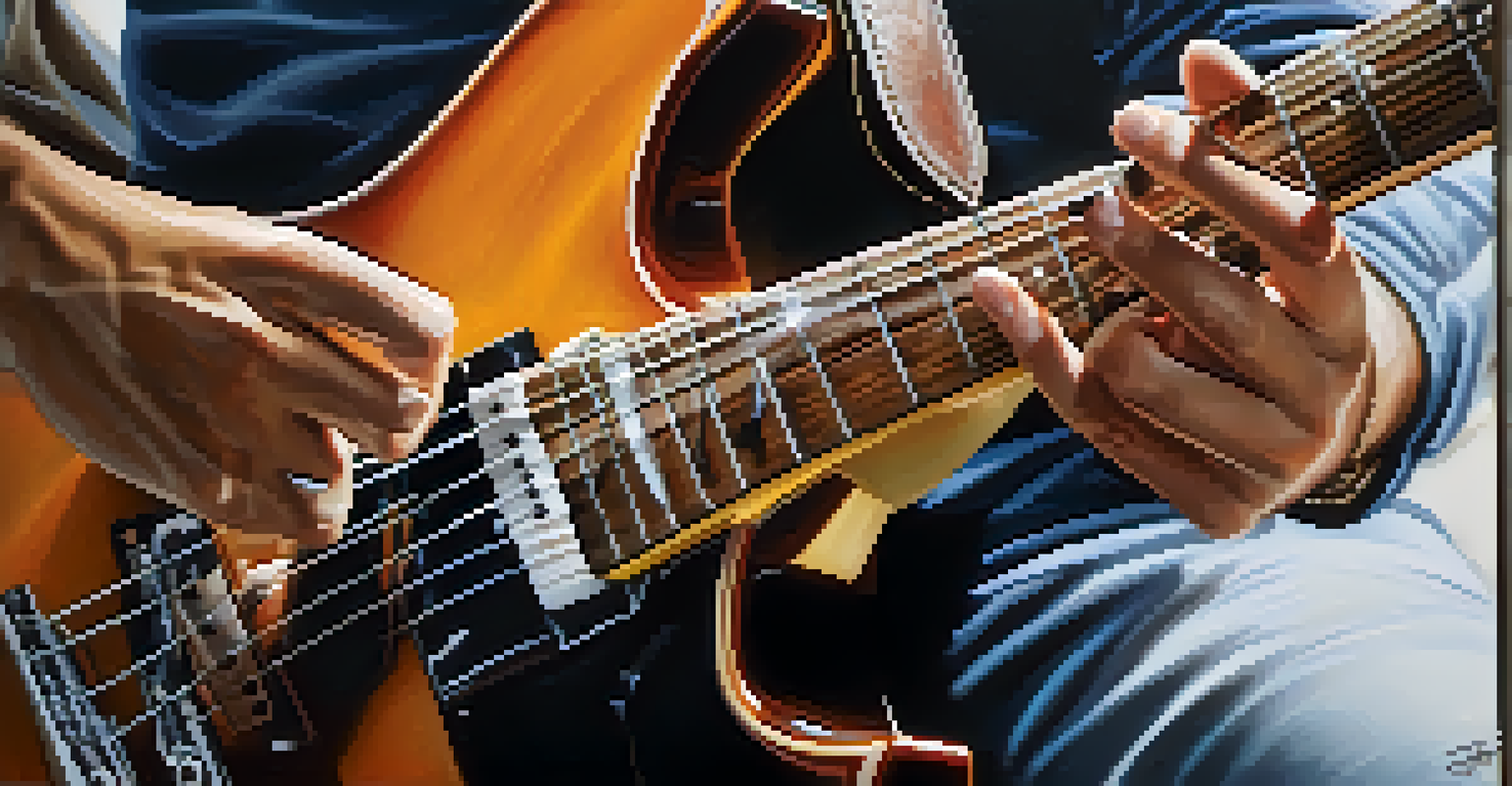Exploring Pentatonic Scales for Guitar Improvisation Mastery

What Are Pentatonic Scales and Why Use Them?
Pentatonic scales are five-note scales that are incredibly versatile and widely used across various music genres. They strip away some of the complexity of traditional scales, making them easier to play and improvise with. This simplicity allows guitarists to focus on expression and creativity rather than getting bogged down in technicalities.
Music is the shorthand of emotion.
One of the reasons pentatonic scales are so popular is their compatibility with many chords and progressions. Whether you're jamming over blues, rock, or even pop songs, these scales fit right in, allowing for seamless improvisation. Think of them as a painter's basic colors; with just these five notes, you can create a vast array of musical landscapes.
Moreover, pentatonic scales can help you build confidence as a guitarist. Beginners often find these scales more approachable, which can lead to quicker progress in improvisation skills. As you become comfortable, you'll discover that the pentatonic scale is a stepping stone to more complex musical ideas.
Understanding the Major and Minor Pentatonic Scales
The major and minor pentatonic scales are the two most common types. The major pentatonic scale has a happy, bright sound, while the minor pentatonic scale evokes a more soulful or bluesy feeling. Understanding these two scales will help you choose the right one based on the emotion you want to convey in your improvisation.

For example, if you're playing a song in C major, you can use the C major pentatonic scale, which consists of the notes C, D, E, G, and A. Conversely, if you're jamming over an A minor track, the A minor pentatonic scale (A, C, D, E, G) is your go-to. This flexibility allows guitarists to express different moods and styles effortlessly.
Pentatonic Scales Simplify Improvisation
Pentatonic scales, with their five notes, allow guitarists to focus on creativity and expression, making improvisation more accessible.
It's worth noting that both scales share the same notes, just presented in different contexts. This relationship between major and minor scales opens up a world of creative possibilities, allowing you to switch between the two as you improvise.
The Five Positions of the Pentatonic Scale
Pentatonic scales can be played in multiple positions across the guitar neck, and there are five main positions to master. Each position offers a unique set of finger patterns and note arrangements, giving you various ways to navigate your improvisation. By familiarizing yourself with these positions, you can increase your versatility as a guitarist.
The music is not in the notes, but in the silence between.
For instance, the first position of the A minor pentatonic scale starts on the 5th fret of the low E string. As you move up the neck, each position allows for different fingerings and tones, expanding your improvisation toolkit. This familiarity helps you seamlessly transition between positions during a solo, making your playing more dynamic.
Practicing these positions not only enhances your muscle memory but also deepens your understanding of the guitar fretboard. You'll start to see how the notes connect, allowing for more expressive and fluent improvisation.
Techniques for Improvising with Pentatonic Scales
Once you're comfortable with the pentatonic scales, it's time to explore various techniques that can spice up your improvisation. Techniques like bending, hammer-ons, pull-offs, and slides can add emotional depth and flair to your solos. These techniques allow you to break away from straightforward note playing, making your music more engaging.
For example, bending a note can create a sense of longing or tension, while a quick hammer-on can inject excitement into your playing. Experimenting with these techniques will help you discover your unique voice on the guitar. Remember, improvisation is as much about feeling as it is about the notes themselves.
Mastering Major and Minor Scales
Understanding the major and minor pentatonic scales enables guitarists to convey different emotions and styles in their playing.
As you practice, try incorporating these techniques into your improvisation exercises. Gradually, you'll find them becoming a natural part of your playing, allowing you to express yourself more freely and creatively.
Listening and Learning from Great Guitarists
One of the best ways to master pentatonic scales is by listening to great guitarists who excel at improvisation. Artists like Eric Clapton, Jimi Hendrix, and B.B. King have all utilized pentatonic scales in their solos. By studying their techniques, phrasing, and note choices, you can gain insights into how to effectively use these scales.
Try to transcribe some of your favorite solos and pay attention to how these guitarists navigate the pentatonic scales. Notice how they combine techniques and create tension and resolution in their playing. This practice not only improves your ear but also gives you a wealth of ideas to incorporate into your own improvisation.
Additionally, consider jamming along with recordings of these artists. This practical experience will help you apply what you've learned, allowing you to internalize the sounds and techniques that make pentatonic improvisation so powerful.
Creating Your Own Melodies with Pentatonic Scales
Improvisation is about creativity, and pentatonic scales provide the perfect foundation for crafting your own melodies. Start by playing around with the notes in the scale, experimenting with different sequences and rhythms. Don't be afraid to let your intuition guide you; often, the most beautiful melodies come from spontaneous ideas.
As you play, focus on building phrases that express an emotion or tell a story. Remember, music is a form of communication, and your melodies should resonate with your audience. Try to incorporate silence and pauses, as these can enhance the impact of your phrases and make your playing more compelling.
Techniques Enhance Musical Expression
Incorporating techniques like bends and slides into pentatonic scales enriches solos, making them more engaging and expressive.
Over time, you'll develop a personal style that reflects your musical identity. The more you experiment and create, the more confident you'll become in your improvisational abilities.
Practicing and Applying What You've Learned
Like any skill, mastering pentatonic scales for improvisation requires consistent practice. Set aside dedicated time each week to work on your scales, techniques, and improvisational skills. This structured approach will help you track your progress and stay motivated as you develop your abilities.
Consider using backing tracks in various styles to practice your improvisation. This not only makes practice more enjoyable but also simulates real playing situations. As you experiment with different styles, you'll learn how to adapt your pentatonic scale knowledge to various musical contexts.

Lastly, remember to be patient with yourself. Mastery takes time, and every guitarist progresses at their own pace. Celebrate small victories along the way, and keep pushing your boundaries to become a more confident improviser.